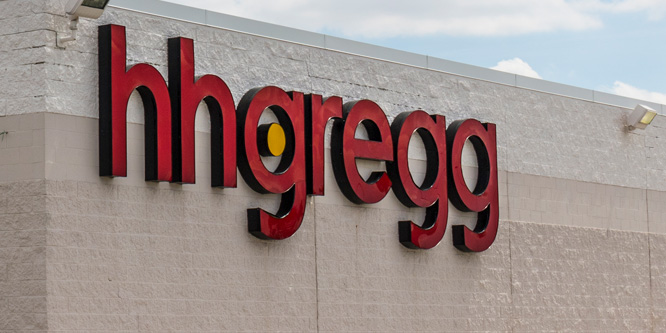
Photo: Getty Images
H.H. Gregg makes its big return with a pint-sized store
H.H. Gregg, the electronics retailer that liquidated two years ago, has returned to physical retail with a store that measures under 2,000 square feet — a fraction of its former average size of 25,000 to 30,000 square feet.
The store, at the Cedar Grove Shopping Center in Somerset, NJ, was opened by Valor Group, a New Jersey-based firm that outbid Sears and Best Buy to secure the rights to H.H. Gregg’s website, customer files and trademarks during bankruptcy proceedings. Within months of the deal, H.H. Gregg’s online website was back and a brick and mortar return was promised.
“We’re very aware of retail trends and the emerging strategy of a smaller physical location,” said Eli Sapharti, director of retail operations at Valor Group, in a statement. “Combining market trends with our own analysis of 25 million H.H. Gregg customer records, we recognized this is the most effective way to keep providing consumers with the same service and trusted name that H.H. Gregg built since its founding in 1955.”
He further told New Jersey’s Franklin Reporter & Advocate that H.H. Gregg’s larger footprint played a role in the chain’s downfall.
“This is a more personalized space where you can learn one-on-one,” he said of the smaller store. “We have experts in the consumer electronics field, if you want to compare one item to another or one brand to another. It’s a personalized, smaller space that you won’t feel overwhelmed in.”
The smaller store is able to carry a wide array of top electronics brands, including Apple, Samsung and JBL, as well as top camera and kitchen appliance brands. Nearby warehouse space supports inventory needs.
No information on additional stores was provided, but management says they are looking to physical stores to spur online sales because of the need for consumers to handle and test electronics in person.
“We definitely see the value in a brick & mortar location,” said Mr. Sapharti in the statement. “And we are also intimately aware that physical locations and overly rapid expansion is death to any company aiming for long years of success.”
Discussion Questions
DISCUSSION QUESTIONS: Do you see more pros than cons in H.H. Gregg’s return to physical retail as a much smaller concept? What challenges does a small store present?


When looking at the former chain and asking if they could make a comeback, I can’t help but remember why they went out of business and think about what it would take now to bring life into a dead business. H.H. Gregg was a secure retailer with virtually no debt, but from years of poor leadership and a business model that was like shopping in the 1960s, they lost their edge and customers found other places to shop. Also, they developed an abysmal reputation for taking advantage of the customer. So now with a new venture, they won’t find the same nostalgic audience like Toys “R” Us because H.H. Gregg’s customers were not happy ones. Can the new chain make it? That’s a big question. Brick-and-mortar for consumer electronics has some advantages because customers do like to see and try out the merchandise. However, the in-store experience will have to be extremely powerful, making customers not only want to shop but, most importantly, come back and tell their friends. That’s not an easy task to achieve.
Keeping the store small is wise, but again it has to be exciting, memorable, and something customers will talk about to others they know.
Customers might welcome an opportunity to compare notes with an expert to choose the right appliance, then have it delivered. Still, given the wide variety of SKUs that H.H. Gregg used to sell, it’s hard to imagine that the new advise-and-buy model can be profitable.
The original H.H. Gregg’s was built on having a wide variety of products in every electronics category. This required a similar store size as Best Buy and others. I only visited one once and was underwhelmed. I saw nothing that would encourage me to shop there rather than the very nearby Best Buy.
The pro of the new concept is that a smaller store and a limited selection of products allows them to get back into brick-and-mortar retail with minimal risk. The major con is that people are likely to come to the store expecting to see what they would have seen and be disappointed to see what they are seeing.
The real challenge for the new H.H. Gregg is, how will they differentiate this new in-store experience from what a customer gets at Best Buy, which despite the store footprint size, is still the logical competition for them? That experience will need to be quite compelling, delivering strong product knowledge and, more importantly, understanding of the customer’s needs. If they can do that, they may succeed. However I don’t think their brand has any nostalgic value for previous customers. Their stores had essentially been decaying for some time and most customers won’t have fond memories to look back on. The situation isn’t like Toys “R” Us.
I’m not going to say it’s wrong, but I am going to say if it’s right, I can’t see how; there are different kinds of stores. Some are both sale and distribution points and have to have sufficient inventory on hand, while others are really more showrooms (this would be the case, I’m guessing, with appliances). But 2000 gsf doesn’t sound big enough for either of these, and at less than 10% of their former size it’s clearly a different concept. Given that the first concept failed that may not be such a bad thing, but it’s no guarantee of a good thing either.